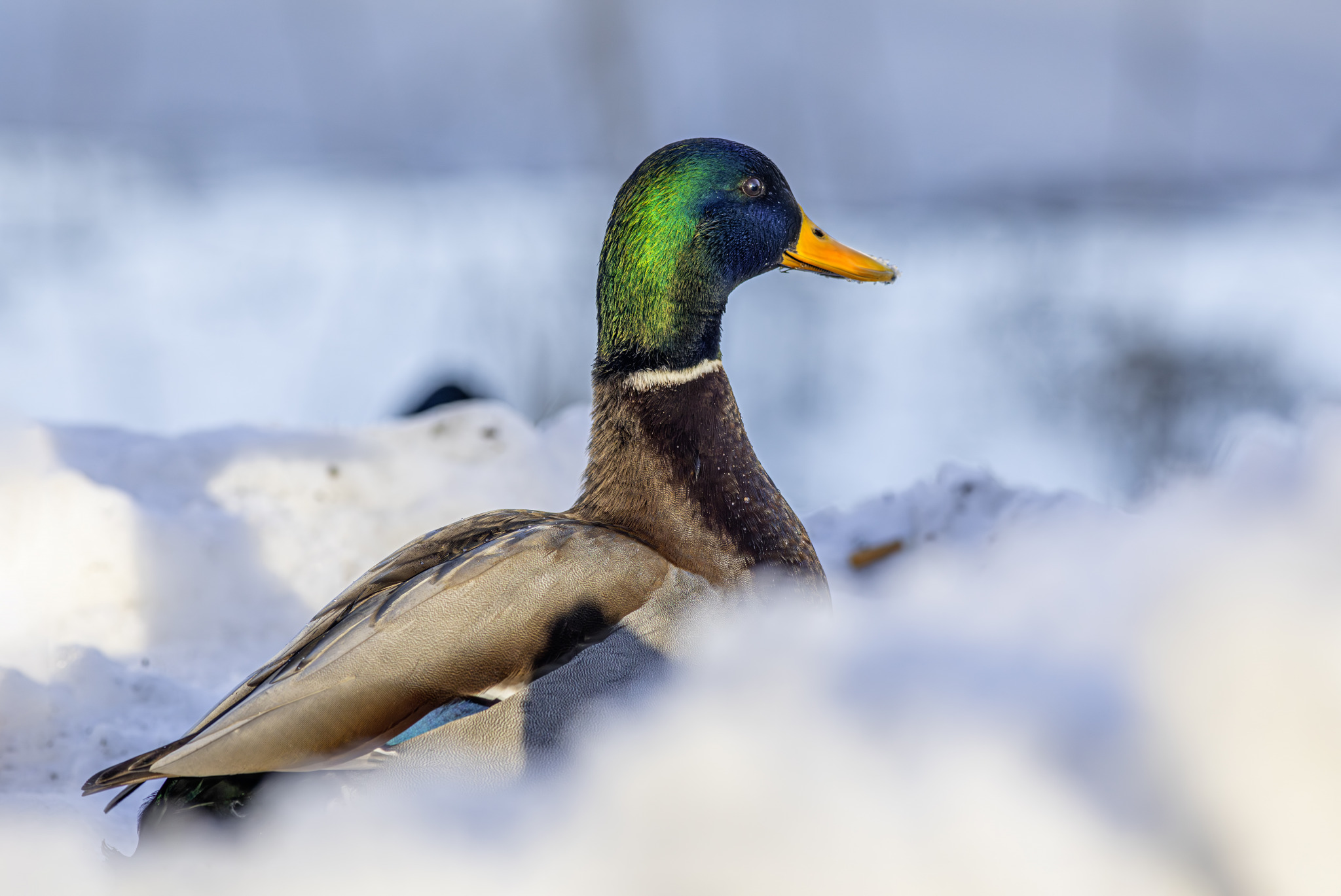The Wild Duck generally refers to the Mallard (Anas platyrhynchos), which is the most common and widespread wild duck species across much of the Northern Hemisphere. It is the ancestor of most domestic duck breeds and is known for its adaptability to various habitats, making it a familiar sight in wetlands, parks, and urban areas.
Physical Description:
- Size: Mallards are medium to large ducks, with males (drakes) measuring about 50 to 65 cm in length and weighing around 1 to 1.5 kg. Females (hens) are slightly smaller.
- Males (Drakes): The male mallard is unmistakable during the breeding season with its glossy green head, white neck ring, and chestnut-brown chest. The body is primarily gray, with a black tail and a bright blue or purplish patch on the wings (speculum) bordered by white.
- Females (Hens): The female is mottled brown with an orange bill and also has the characteristic blue speculum on the wings. Her plumage provides excellent camouflage in natural habitats.
- Bill: Both sexes have a flattened, broad bill, though the male’s is yellowish, while the female’s is more orange or brown.
- Feet: They have bright orange webbed feet, which help them swim efficiently.
Behavior:
- Flight: Mallards are strong fliers and can reach speeds of up to 65 km/h (40 mph). They are capable of long-distance migration and are often seen flying in a characteristic “V” formation.
- Feeding: Mallards are omnivorous and feed by dabbling, meaning they tip forward in the water to forage for aquatic plants, insects, and small fish. They also graze on land, eating grasses, seeds, and grains. In urban areas, they are known to scavenge food from humans.
- Social Behavior: Mallards are social birds, often found in small flocks, especially outside the breeding season. During migration, they may gather in large groups.
Habitat:
Mallards are highly adaptable and can thrive in a wide range of habitats, including:
- Wetlands: Ponds, lakes, rivers, marshes, and estuaries.
- Urban Areas: Mallards are commonly found in parks, golf courses, and urban lakes or ponds, often accustomed to humans feeding them.
- Coastal Waters: They are also found in brackish coastal waters and tidal marshes.
Distribution:
Mallards are found across the Northern Hemisphere in Europe, Asia, and North America. Their range extends from the Arctic tundra in summer (for breeding) to temperate and subtropical regions during the winter. In many regions, they are year-round residents.
Reproduction and Life Cycle:
- Breeding Season: The breeding season typically begins in early spring. Mallards are known for their courtship displays, where the males show off their bright plumage and engage in various displays to attract a mate.
- Nesting: Females build their nests on the ground, usually hidden in vegetation near water. They may also nest in more unusual places such as tree hollows, rooftops, or even balconies in urban areas.
- Eggs: Females lay a clutch of 8 to 13 creamy white to pale green eggs. The eggs are incubated by the female alone for about 28 days.
- Ducklings: Once hatched, the ducklings are precocial, meaning they are able to walk and swim shortly after birth. The mother leads them to water, where they begin feeding and growing rapidly. The ducklings are fully fledged and independent at about 50-60 days of age.
Migration:
Mallards are partial migrants, with populations in the northern parts of their range migrating south in the winter, while others remain year-round residents if the climate is mild. They migrate to avoid freezing conditions and to access open water and food sources.
Conservation Status:
Mallards are classified as Least Concern by the IUCN due to their large population and wide distribution. They are one of the most abundant and successful waterfowl species globally. However, they face threats such as habitat loss, pollution, and hybridization with domestic ducks.
Interesting Facts:
- Domestication: Mallards are the ancestors of almost all domestic duck breeds. The domestication of mallards likely began thousands of years ago in Asia and Europe.
- Hybridization: Mallards are known to hybridize with other duck species, including domestic ducks, which has led to some concerns about genetic dilution in certain regions.
- Quacking: Only female mallards produce the classic “quack” sound. Males are generally quieter, making softer raspy sounds.
- Adaptability: Mallards are extremely adaptable and can thrive in a variety of environments, from the wildest wetlands to highly urbanized areas.
Ecological Role:
Mallards play an important role in ecosystems as herbivores and as prey for predators. They help control aquatic vegetation and are also a key food source for animals such as foxes, raccoons, birds of prey, and large fish. Additionally, they contribute to the dispersal of seeds and aquatic invertebrates.
Conclusion:
The Wild Duck, or Mallard (Anas platyrhynchos), is an adaptable and widespread species that has thrived in various environments across the globe. With its characteristic green-headed males, friendly behavior in urban settings, and strong migratory habits, it remains one of the most recognizable and successful waterfowl species worldwide.
Views: 1271
Subscribe to the newsletter:
